A WHS audit is a systematic examination of an organization’s health and safety management systems to ensure compliance with established standards and regulations. ISO 45001 is an international standard that specifies requirements for an occupational health and safety management system (OHSMS). It aims to improve employee safety, reduce workplace risks, and create better, safer working conditions.
Why WHS Audit Preparation Matters
- Minimizes Disruptions: Proper audit preparation helps minimize disruptions to daily operations. When an organization is well-prepared, the audit process can be conducted smoothly without causing significant interruptions to business activities.
- Ensures Compliance: Being prepared for a WHS audit ensures that the organization complies with relevant laws, regulations, and standards, including ISO 45001. This is particularly important for industries with strict regulatory requirements.
- Identifies Weaknesses: Audit preparation involves a thorough review of the organization’s processes and records. This helps identify weaknesses and areas that need improvement, allowing the organization to address these issues before the audit.
- Builds Trust: A successful WHS audit builds trust with stakeholders, including employees, customers, investors, and regulatory bodies. It demonstrates the organization’s commitment to health and safety.
- Reduces Stress: Preparing for a WHS audit in advance reduces the stress and anxiety associated with the audit process. When everything is in order, the organization can approach the audit with confidence.
Steps to Effective WHS Audit Preparation
- Understand the Scope: The first step in WHS audit preparation is to understand the scope of the audit. This includes knowing what areas will be audited, the criteria that will be used, and the documentation that will be required.
- Create an Audit Plan: Develop a detailed audit plan that outlines the steps to be taken, the timeline, and the responsibilities of each team member. This plan should include a checklist of all the documents and records that need to be prepared.
- Gather Documentation: Collect all the necessary documentation and records well in advance of the audit. This includes health and safety policies, risk assessments, incident reports, training records, and any other relevant documents.
- Conduct a Pre-Audit Review: Before the actual audit, conduct a pre-audit review to identify any potential issues. This involves reviewing the documentation, checking for compliance with ISO 45001, and addressing any discrepancies.
- Train Staff: Ensure that all staff members involved in the audit process are well-trained and understand their roles and responsibilities. This includes providing training on how to respond to auditor inquiries and how to present documentation.
- Communicate with Auditors: Maintain open communication with the auditors throughout the audit process. This includes providing them with the necessary information and addressing any questions or concerns they may have.
- Review and Improve: After the audit, review the findings and recommendations. Use this feedback to make improvements to the organization’s health and safety management system and prepare for future audits.
Benefits of WHS Audit Preparation
- Improved Efficiency: Proper WHS audit preparation leads to improved efficiency in the audit process. When everything is organized and ready, the audit can be completed more quickly and with fewer disruptions.
- Enhanced Compliance: Being prepared for a WHS audit ensures that the organization complies with all relevant regulations and standards, including ISO 45001. This reduces the risk of non-compliance and the associated penalties.
- Better Risk Management: WHS audit preparation helps identify and mitigate risks. By addressing weaknesses and implementing improvements, the organization can reduce the likelihood of future issues.
- Increased Transparency: A well-prepared WHS audit demonstrates the organization’s commitment to transparency and accountability. This builds trust with stakeholders and enhances the organization’s reputation.
- Continuous Improvement: The WHS audit process provides valuable feedback that can be used to make continuous improvements. By addressing the findings and recommendations, the organization can enhance its health and safety management system and achieve better results.
Conclusion
WHS audit preparation is a critical aspect of the audit process. It ensures that the organization is ready for the audit, complies with relevant regulations, and can address any issues that arise. By following the steps outlined in this blog, organizations can achieve a successful WHS audit and reap the benefits of improved efficiency, enhanced compliance, better risk management, increased transparency, and continuous improvement.
In summary, the importance of WHS audit preparation cannot be overstated. It is an essential part of maintaining a well-functioning and compliant organization. By investing time and effort into WHS audit preparation, organizations can ensure a smooth and successful audit process, build trust with stakeholders, and achieve long-term success.
Please contact Beaumont Solutions today if you need WHS Consultants to support you in your audit preparation.



